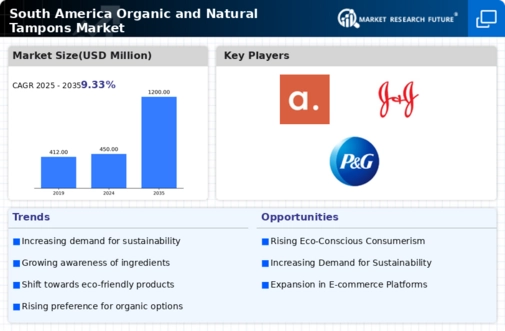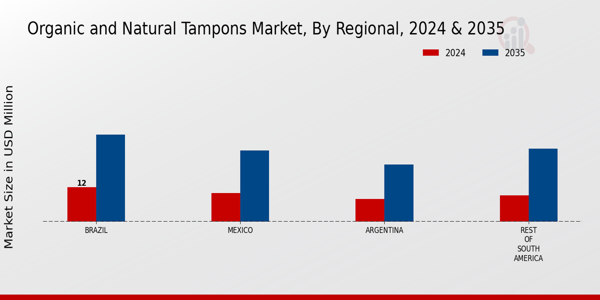-
EXECUTIVE
-
SUMMARY
-
Market Overview
-
Key Findings
-
Market Segmentation
-
Competitive Landscape
-
Challenges and Opportunities
-
Future Outlook
-
MARKET INTRODUCTION
-
Definition
-
Scope of the study
-
Research Objective
-
Assumption
-
Limitations
-
RESEARCH
-
METHODOLOGY
-
Overview
-
Data
-
Mining
-
Secondary Research
-
Primary
-
Research
-
Primary Interviews and Information Gathering
-
Process
-
Breakdown of Primary Respondents
-
Forecasting
-
Model
-
Market Size Estimation
-
Bottom-Up
-
Approach
-
Top-Down Approach
-
Data
-
Triangulation
-
Validation
-
MARKET
-
DYNAMICS
-
Overview
-
Drivers
-
Restraints
-
Opportunities
-
MARKET FACTOR ANALYSIS
-
Value chain Analysis
-
Porter's
-
Five Forces Analysis
-
Bargaining Power of Suppliers
-
Bargaining
-
Power of Buyers
-
Threat of New Entrants
-
Threat
-
of Substitutes
-
Intensity of Rivalry
-
COVID-19
-
Impact Analysis
-
Market Impact Analysis
-
Regional
-
Impact
-
Opportunity and Threat Analysis
-
South
-
America Organic and Natural Tampons Market, BY Type (USD Million)
-
Cardboard
-
Applicator
-
Plastic Applicator
-
Digital
-
Tampon
-
South America Organic
-
and Natural Tampons Market, BY Size (USD Million)
-
Junior
-
Tampons
-
Regular Tampons
-
Super
-
Super-Plus
-
South
-
America Organic and Natural Tampons Market, BY Odour (USD Million)
-
Fragrance
-
Based
-
Non-Fragrance Based
-
South
-
America Organic and Natural Tampons Market, BY Regional (USD Million)
-
Brazil
-
Mexico
-
Argentina
-
Rest
-
of South America
-
Competitive Landscape
-
Overview
-
Competitive
-
Analysis
-
Market share Analysis
-
Major
-
Growth Strategy in the Organic and Natural Tampons Market
-
Competitive
-
Benchmarking
-
Leading Players in Terms of Number of Developments
-
in the Organic and Natural Tampons Market
-
Key developments
-
and growth strategies
-
New Product Launch/Service Deployment
-
Merger
-
& Acquisitions
-
Joint Ventures
-
Major
-
Players Financial Matrix
-
Sales and Operating Income
-
Major
-
Players R&D Expenditure. 2023
-
Company
-
Profiles
-
Lola
-
Financial
-
Overview
-
Products Offered
-
Key
-
Developments
-
SWOT Analysis
-
Key
-
Strategies
-
Thinx
-
Financial
-
Overview
-
Products Offered
-
Key
-
Developments
-
SWOT Analysis
-
Key
-
Strategies
-
Tampon Tribe
-
Financial
-
Overview
-
Products Offered
-
Key
-
Developments
-
SWOT Analysis
-
Key
-
Strategies
-
Hello Cup
-
Financial
-
Overview
-
Products Offered
-
Key
-
Developments
-
SWOT Analysis
-
Key
-
Strategies
-
KimberlyClark
-
Financial
-
Overview
-
Products Offered
-
Key
-
Developments
-
SWOT Analysis
-
Key
-
Strategies
-
Ruby Cup
-
Financial
-
Overview
-
Products Offered
-
Key
-
Developments
-
SWOT Analysis
-
Key
-
Strategies
-
Be informed
-
Financial
-
Overview
-
Products Offered
-
Key
-
Developments
-
SWOT Analysis
-
Key
-
Strategies
-
Procter & Gamble
-
Financial
-
Overview
-
Products Offered
-
Key
-
Developments
-
SWOT Analysis
-
Key
-
Strategies
-
Natracare
-
Financial
-
Overview
-
Products Offered
-
Key
-
Developments
-
SWOT Analysis
-
Key
-
Strategies
-
Herbal Essences
-
Financial
-
Overview
-
Products Offered
-
Key
-
Developments
-
SWOT Analysis
-
Key
-
Strategies
-
Cora
-
Financial
-
Overview
-
Products Offered
-
Key
-
Developments
-
SWOT Analysis
-
Key
-
Strategies
-
Organicup
-
Financial
-
Overview
-
Products Offered
-
Key
-
Developments
-
SWOT Analysis
-
Key
-
Strategies
-
Rael
-
Financial
-
Overview
-
Products Offered
-
Key
-
Developments
-
SWOT Analysis
-
Key
-
Strategies
-
Unilever
-
Financial
-
Overview
-
Products Offered
-
Key
-
Developments
-
SWOT Analysis
-
Key
-
Strategies
-
References
-
Related
-
Reports
-
LIST
-
OF ASSUMPTIONS
-
South America Organic and Natural Tampons
-
Market SIZE ESTIMATES & FORECAST, BY TYPE, 2019-2035 (USD Billions)
-
South
-
America Organic and Natural Tampons Market SIZE ESTIMATES & FORECAST, BY SIZE,
-
2035 (USD Billions)
-
South America Organic and Natural
-
Tampons Market SIZE ESTIMATES & FORECAST, BY ODOUR, 2019-2035 (USD Billions)
-
South
-
America Organic and Natural Tampons Market SIZE ESTIMATES & FORECAST, BY REGIONAL,
-
2035 (USD Billions)
-
PRODUCT LAUNCH/PRODUCT DEVELOPMENT/APPROVAL
-
ACQUISITION/PARTNERSHIP
-
LIST
-
Of figures
-
MARKET SYNOPSIS
-
SOUTH
-
AMERICA ORGANIC AND NATURAL TAMPONS MARKET ANALYSIS BY TYPE
-
SOUTH
-
AMERICA ORGANIC AND NATURAL TAMPONS MARKET ANALYSIS BY SIZE
-
SOUTH
-
AMERICA ORGANIC AND NATURAL TAMPONS MARKET ANALYSIS BY ODOUR
-
SOUTH
-
AMERICA ORGANIC AND NATURAL TAMPONS MARKET ANALYSIS BY REGIONAL
-
KEY
-
BUYING CRITERIA OF ORGANIC AND NATURAL TAMPONS MARKET
-
RESEARCH
-
PROCESS OF MRFR
-
DRO ANALYSIS OF ORGANIC AND NATURAL TAMPONS
-
MARKET
-
DRIVERS IMPACT ANALYSIS: ORGANIC AND NATURAL TAMPONS
-
MARKET
-
RESTRAINTS IMPACT ANALYSIS: ORGANIC AND NATURAL
-
TAMPONS MARKET
-
SUPPLY / VALUE CHAIN: ORGANIC AND NATURAL
-
TAMPONS MARKET
-
ORGANIC AND NATURAL TAMPONS MARKET, BY
-
TYPE, 2025 (% SHARE)
-
ORGANIC AND NATURAL TAMPONS MARKET,
-
BY TYPE, 2019 TO 2035 (USD Billions)
-
ORGANIC AND NATURAL
-
TAMPONS MARKET, BY SIZE, 2025 (% SHARE)
-
ORGANIC AND NATURAL
-
TAMPONS MARKET, BY SIZE, 2019 TO 2035 (USD Billions)
-
ORGANIC
-
AND NATURAL TAMPONS MARKET, BY ODOUR, 2025 (% SHARE)
-
ORGANIC
-
AND NATURAL TAMPONS MARKET, BY ODOUR, 2019 TO 2035 (USD Billions)
-
ORGANIC
-
AND NATURAL TAMPONS MARKET, BY REGIONAL, 2025 (% SHARE)
-
ORGANIC
-
AND NATURAL TAMPONS MARKET, BY REGIONAL, 2019 TO 2035 (USD Billions)
-
BENCHMARKING
-
OF MAJOR COMPETITORS





